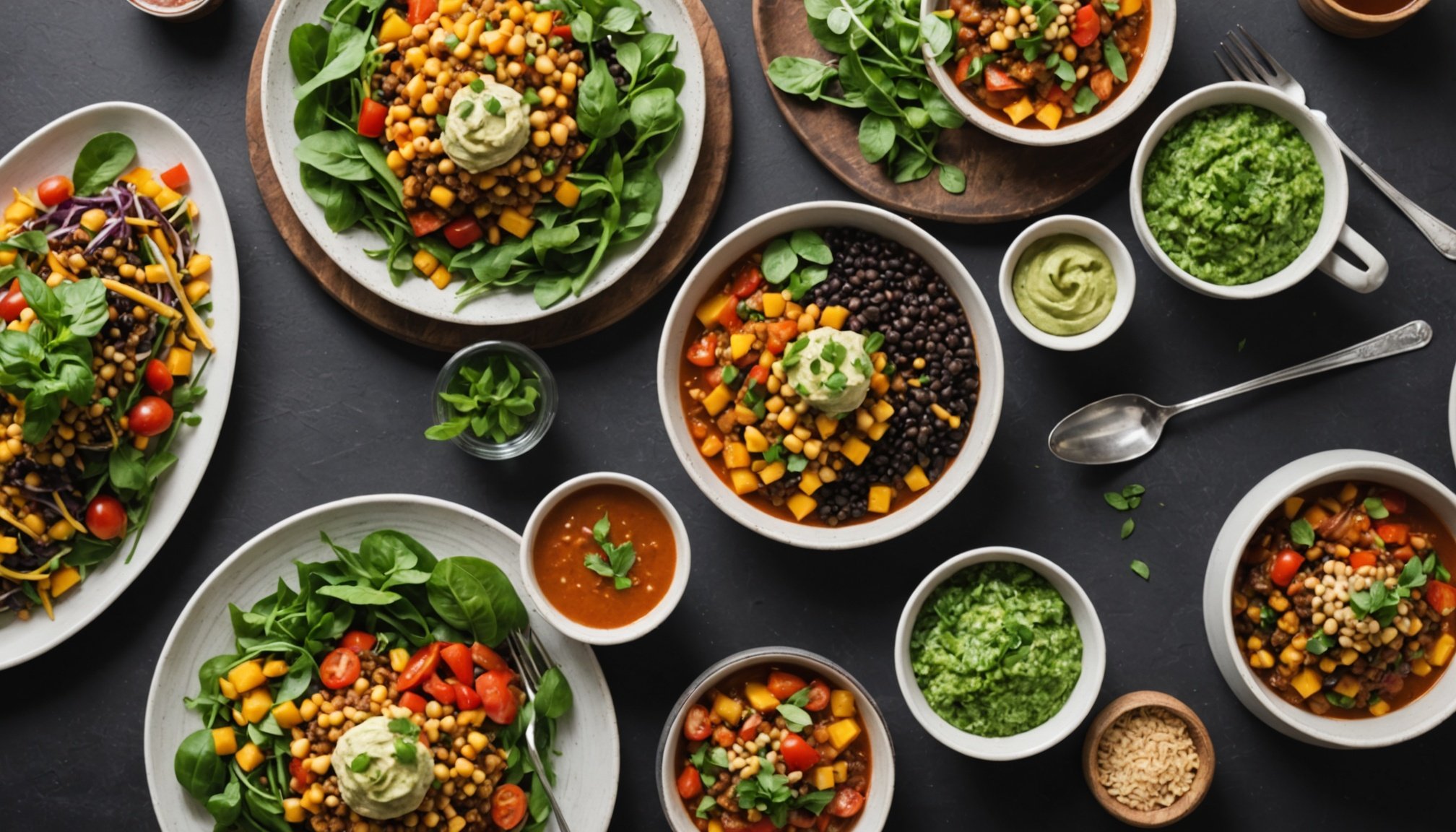Creating delicious vegan dishes can be a delightful challenge. Achieving mouthwatering flavors is essential in winning over both plant-based enthusiasts and skeptics alike. Explore innovative techniques, ingredient pairings, and presentation tips to elevate your plant-based offerings. By focusing on umami-rich ingredients and diverse textures, you can enhance taste profiles and redefine the dining experience. Discover how strategic flavor layering can turn simple vegan dishes into unforgettable culinary experiences that keep customers coming back for more.
Understanding Flavor Profiles in Vegan Cuisine
In the realm of vegan cuisine, achieving a harmonious blend of flavors is crucial. A well-balanced dish typically includes sweet, salty, bitter, and umami elements. These flavor profiles create a symphony of taste that can elevate a meal from ordinary to extraordinary.
In the same genre : Designing a memorable cocktail menu: expert tips for your bar”s one-of-a-kind signature drinks
One common pitfall in vegan cooking is the absence of umami, often provided by animal products. To enhance taste without these ingredients, consider using mushrooms, nutritional yeast, or fermented foods like soy sauce or miso. These options not only add depth but also enrich the overall flavor profile.
Another technique is to balance sweetness and bitterness. For instance, adding a touch of maple syrup or agave nectar can counteract the bitterness of greens like kale or spinach. Similarly, incorporating citrus zest can brighten and enhance the flavors, making the dish more appealing.
In the same genre : Create an inviting café experience: proven strategies for designing a cozy atmosphere
Taste enhancement in vegan dishes can also be achieved through the use of herbs and spices. Fresh herbs like basil, cilantro, and mint, or spices such as cumin and smoked paprika, can provide robust flavors without relying on animal products. By understanding and applying these techniques, one can create delicious vegan meals that satisfy the palate.
Innovative Ingredients for Flavor Enhancement
In the world of plant-based cooking, discovering unique ingredients can significantly contribute to flavor enhancement. One effective approach is to explore umami-rich components. Ingredients such as mushrooms and fermented foods like miso or soy sauce can add a profound depth to dishes, compensating for the lack of animal-based umami.
Exploring Umami-Rich Ingredients
Mushrooms are a versatile choice, offering a rich, earthy taste that complements various recipes. Fermented foods not only provide umami but also introduce complex flavors that can elevate a dish. Incorporating these into your cooking can transform simple meals into gourmet experiences.
Utilizing Spices and Herbs
Herbs and spices are indispensable in creating depth and character in plant-based dishes. For instance, cumin and smoked paprika can add warmth and smokiness, while fresh herbs like basil and cilantro bring a refreshing note. These elements work together to form a well-rounded flavor profile.
The Role of Alternative Fats and Oils
Alternative fats and oils, such as avocado oil or coconut oil, play a crucial role in flavor development. They can add richness and enhance the overall taste of a dish, making them essential in crafting delicious vegan meals.
Techniques for Elevating Vegan Dishes
Exploring various culinary techniques can significantly enhance the taste and appeal of vegan dishes. By employing specific cooking methods, you can transform simple ingredients into flavorful masterpieces.
Roasting and Grilling for Maximum Flavor
Roasting and grilling are powerful cooking methods that can elevate the flavors of vegetables and plant-based proteins. The application of heat caramelizes natural sugars, intensifying sweetness and adding a smoky dimension. This process also enhances texture, giving vegetables a delightful crispiness and proteins a satisfying char.
Marinating and Brining for Depth
Marinating and brining are essential culinary techniques for infusing depth into vegan dishes. Marination involves soaking ingredients in a mixture of herbs, spices, and acids, which penetrates the food and enhances its flavor profile. Brining, on the other hand, involves soaking in a saltwater solution, improving texture and juiciness. Both methods ensure that every bite is packed with taste.
Infusing Oils and Stocks
Creating infused oils and stocks is another technique to add layers of flavor to your dishes. By simmering herbs and spices in oils or stocks, you can develop a flavorful base for sauces and soups. These infusions provide a rich, aromatic foundation that enhances the complexity of any vegan dish.
Case Studies from Successful Plant-Based Eateries
In the realm of plant-based eateries, success stories often revolve around unique flavor combinations and culinary innovation. These establishments have mastered the art of crafting memorable dishes that captivate both the palate and the imagination.
Highlighting Unique Flavor Combinations
Several renowned restaurants have gained acclaim for their inventive use of ingredients. For example, a popular eatery in London combines jackfruit with smoked paprika and citrus zest, creating a dish that is both smoky and refreshing. This kind of flavor innovation sets them apart from competitors.
Testimonials from Chefs
Chefs at these successful eateries frequently share insights into their favorite techniques. One chef noted the transformative power of marinating tofu in a blend of miso, ginger, and maple syrup, resulting in a complex, savory profile. Such testimonials underscore the importance of experimentation and creativity in plant-based cooking.
Analyzing Customer Feedback
Customer feedback often highlights the appeal of innovative vegan dishes. Diners appreciate the bold flavors and textures that challenge their expectations of plant-based cuisine. This positive reception not only drives repeat visits but also encourages eateries to continue pushing the boundaries of flavor innovation.
Overcoming Common Challenges in Vegan Cooking
Navigating vegan cooking challenges often requires a blend of creativity and innovation. One frequent issue is achieving the right texture in plant-based dishes. Without animal products, textures can sometimes fall flat. To tackle this, consider using ingredients like jackfruit or cauliflower, which can mimic the texture of meat when cooked properly. Additionally, incorporating nuts and seeds can add a satisfying crunch to your meals.
Enhancing flavor in budget-friendly recipes is another challenge. Often, limited ingredients can lead to bland dishes. To counteract this, focus on culinary innovation by using spices and herbs strategically. For instance, cumin, coriander, and turmeric can transform a simple lentil dish into a flavourful delight. Also, don't shy away from using vinegar or lemon juice to add a zesty kick.
Lastly, avoiding unappetizing meals means experimenting with different cooking techniques. Roasting, grilling, and sautéing can bring out the natural sweetness and depth of vegetables. This not only enhances the overall taste but also ensures your vegan dishes are both delicious and visually appealing. Embrace these strategies to overcome common vegan cooking hurdles with ease.











